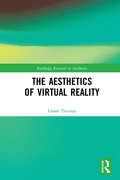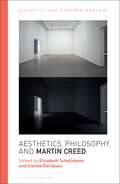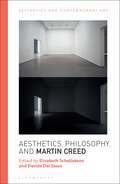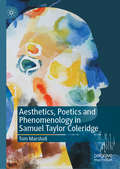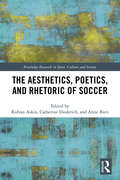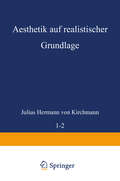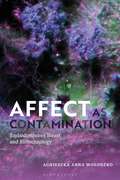- Table View
- List View
The Aesthetics of Virtual Reality (Routledge Research in Aesthetics)
by Grant TavinorThis is the first book to present an aesthetics of virtual reality media. It situates virtual reality media in terms of the philosophy of the arts, comparing them to more familiar media such as painting, film and photography. When philosophers have approached virtual reality, they have almost always done so through the lens of metaphysics, asking questions about the reality of virtual items and worlds, about the value of such things, and indeed, about how they may reshape our understanding of the "real" world. Grant Tavinor finds that approach to be fundamentally mistaken, and that to really account for virtual reality, we must focus on the medium and its uses, and not the hypothetical and speculative instances that are typically the focus of earlier works. He also argues that much of the cultural and metaphysical hype around virtual reality is undeserved. But this does not mean that virtual reality is illusory or uninteresting; on the contrary, it is significant for the altogether different reason that it overturns much of our understanding of how representational media can function and what we can use them to achieve. The Aesthetics of Virtual Reality will be of interest to scholars and advanced students working in aesthetics, philosophy of art, philosophy of technology, metaphysics, and game studies.
Aesthetics of Weather
by Dr Madalina DiaconuIn an age of rife consumption and increasing need for consideration of sustainable social practices, an exploration of the aesthetics of weather from various angles becomes vital in shedding light on its importance to our experience of the changing world. In response, offering the first in-depth and nuanced examination of the aesthetics of weather, this book underlines the relevance the concept has for scientific communication, for fostering sustainable patterns of behaviour and for rejecting the environmentally-damaging “consumption” of landscapes and fine weather. In addition, it provides examples taken from global, contemporary popular culture whilst calling attention to the socioeconomic and political dimensions of individual experience, demonstrating and analysing our fascination with, and cultural interpretations of, weather phenomena in our everyday lives.Within its three sections, the volume reinvents traditional phenomenological methods to create socially, politically and historically embedded 'phenomenographies' and explore the importance of aesthetic practices in shaping our experience of weather and climate. It also provides a deeper engagement with general topics, such as the relationship between perception, emotion, imagination, and cognition in our aesthetic experience of the weather, combining these with aesthetic analyses of the so-called “fine weather”. With its broad scope of inquiry ranging from Aristotle to eco-phenomenology, from the pioneers of scientific meteorology to contemporary art, and from everyday aesthetics to geoengineering, this book argues that an aesthetics of weather inflected by greater knowledge and the taking of a critical stance towards aestheticism can become a valuable ally to climate ethics in the Anthropocene.
Aesthetics of Weather
by Dr Madalina DiaconuIn an age of rife consumption and increasing need for consideration of sustainable social practices, an exploration of the aesthetics of weather from various angles becomes vital in shedding light on its importance to our experience of the changing world. In response, offering the first in-depth and nuanced examination of the aesthetics of weather, this book underlines the relevance the concept has for scientific communication, for fostering sustainable patterns of behaviour and for rejecting the environmentally-damaging “consumption” of landscapes and fine weather. In addition, it provides examples taken from global, contemporary popular culture whilst calling attention to the socioeconomic and political dimensions of individual experience, demonstrating and analysing our fascination with, and cultural interpretations of, weather phenomena in our everyday lives.Within its three sections, the volume reinvents traditional phenomenological methods to create socially, politically and historically embedded 'phenomenographies' and explore the importance of aesthetic practices in shaping our experience of weather and climate. It also provides a deeper engagement with general topics, such as the relationship between perception, emotion, imagination, and cognition in our aesthetic experience of the weather, combining these with aesthetic analyses of the so-called “fine weather”. With its broad scope of inquiry ranging from Aristotle to eco-phenomenology, from the pioneers of scientific meteorology to contemporary art, and from everyday aesthetics to geoengineering, this book argues that an aesthetics of weather inflected by greater knowledge and the taking of a critical stance towards aestheticism can become a valuable ally to climate ethics in the Anthropocene.
Aesthetics on the Edge: Where Philosophy Meets the Human Sciences
by Dominic McIver LopesPhilosophers say what art is and then scientists and then other scholars study how we are equipped, cognitively and socially, to make art and appreciate it. This time-honoured approach will not work. Recent science reveals that we have poor intuitive access to artistic and aesthetic phenomena. Dominic McIver Lopes argues for a new approach that mandates closer integration, from the start, between aesthetics and the human sciences. In these eleven essays he proposes a methodology especially suited to aesthetics, where problems in philosophy are addressed principally by examining how aesthetic phenomena are understood in the human sciences. Since the human sciences include much of the humanities as well as the social, behavioural, and brain sciences, the methodology promises to integrate arts research across the academy. Aesthetics on the Edge opens with a four essays outlining the methodology and its potential. The following essays put the methodology to work, shedding light on the perceptual and social-pragmatic capacities that are implicated in responding to works of art, especially images, but also music, literature, and conceptual art.
Aesthetics on the Edge: Where Philosophy Meets the Human Sciences
by Dominic McIver LopesPhilosophers say what art is and then scientists and then other scholars study how we are equipped, cognitively and socially, to make art and appreciate it. This time-honoured approach will not work. Recent science reveals that we have poor intuitive access to artistic and aesthetic phenomena. Dominic McIver Lopes argues for a new approach that mandates closer integration, from the start, between aesthetics and the human sciences. In these eleven essays he proposes a methodology especially suited to aesthetics, where problems in philosophy are addressed principally by examining how aesthetic phenomena are understood in the human sciences. Since the human sciences include much of the humanities as well as the social, behavioural, and brain sciences, the methodology promises to integrate arts research across the academy. Aesthetics on the Edge opens with a four essays outlining the methodology and its potential. The following essays put the methodology to work, shedding light on the perceptual and social-pragmatic capacities that are implicated in responding to works of art, especially images, but also music, literature, and conceptual art.
Aesthetics, Philosophy and Martin Creed (Aesthetics and Contemporary Art)
by Elisabeth Schellekens and Davide Dal SassoWhat is the future of conceptualism? What expressions can it take in the 21st century? Is there a new role for aesthetic experience in art and, if so, what is that role exactly? Aesthetics, Philosophy and Martin Creed uses one of this generation's most important and influential artists to address themes crucial to contemporary aesthetics. Working in an impressive variety of artistic media, Creed represents a strikingly innovative take on conceptualism. Through his ingenious and thought-provoking work, a team of international philosophers, jurists and art historians illustrate how Creed epitomizes several questions central to philosophical aesthetics today and provides a glimpse of the future both of art and aesthetic discourse. They discuss key concepts for Creed's work, including immediacy (in his photographs of smiling people), compositional order (in his geometric paintings), simplicity (in Work No. 218, a sheet paper crumpled into a ball) and shamelessness (in his videos of vomiting people). By bringing a working artist into the heart of academic discussions, Aesthetics, Philosophy and Martin Creed highlights the relevance of philosophical discussions of art to understanding art today.
Aesthetics, Philosophy and Martin Creed (Aesthetics and Contemporary Art)
by Elisabeth Schellekens Davide Dal SassoWhat is the future of conceptualism? What expressions can it take in the 21st century? Is there a new role for aesthetic experience in art and, if so, what is that role exactly? Aesthetics, Philosophy and Martin Creed uses one of this generation's most important and influential artists to address themes crucial to contemporary aesthetics. Working in an impressive variety of artistic media, Creed represents a strikingly innovative take on conceptualism. Through his ingenious and thought-provoking work, a team of international philosophers, jurists and art historians illustrate how Creed epitomizes several questions central to philosophical aesthetics today and provides a glimpse of the future both of art and aesthetic discourse. They discuss key concepts for Creed's work, including immediacy (in his photographs of smiling people), compositional order (in his geometric paintings), simplicity (in Work No. 218, a sheet paper crumpled into a ball) and shamelessness (in his videos of vomiting people). By bringing a working artist into the heart of academic discussions, Aesthetics, Philosophy and Martin Creed highlights the relevance of philosophical discussions of art to understanding art today.
Aesthetics, Poetics and Phenomenology in Samuel Taylor Coleridge
by Tom MarshallThis book re-evaluates the philosophical status of Samuel Taylor Coleridge by providing an extended comparison between his work and the phenomenological theory of Edmund Husserl. Examining Coleridge’s accounts of the imagination, perception, poetic creativity and literary criticism, it draws a systematic and coherent structure out of a range of Coleridge’s philosophical writing. In addition, it also applies the principles of Coleridge’s philosophy to an interpretation of his own poetic output.
The Aesthetics, Poetics, and Rhetoric of Soccer (Routledge Research in Sport, Culture and Society)
by Ridvan Askin Catherine Diederich Aline BieriSoccer has long been known as 'the beautiful game'. This multi-disciplinary volume explores soccer, soccer culture, and the representation of soccer in art, film, and literature, using the critical tools of aesthetics, poetics, and rhetoric. Including international contributions from scholars of philosophy, literary and cultural studies, linguistics, art history, and the creative arts, this book begins by investigating the relationship between beauty and soccer and asks what criteria should be used to judge the sport’s aesthetic value. Covering topics as diverse as humor, national identity, style, celebrity, and social media, its chapters examine the nature of fandom, the role of language, and the significance of soccer in contemporary popular culture. It also discusses what one might call the ‘stylistics’ of soccer, analyzing how players, fans, and commentators communicate on and off the pitch, in the press, on social media, and in wider public discourse. The Aesthetics, Poetics, and Rhetoric of Soccer makes for fascinating reading for anybody with an interest in sport, culture, literature, philosophy, linguistics, and society.
The Aesthetics, Poetics, and Rhetoric of Soccer (Routledge Research in Sport, Culture and Society)
Soccer has long been known as 'the beautiful game'. This multi-disciplinary volume explores soccer, soccer culture, and the representation of soccer in art, film, and literature, using the critical tools of aesthetics, poetics, and rhetoric. Including international contributions from scholars of philosophy, literary and cultural studies, linguistics, art history, and the creative arts, this book begins by investigating the relationship between beauty and soccer and asks what criteria should be used to judge the sport’s aesthetic value. Covering topics as diverse as humor, national identity, style, celebrity, and social media, its chapters examine the nature of fandom, the role of language, and the significance of soccer in contemporary popular culture. It also discusses what one might call the ‘stylistics’ of soccer, analyzing how players, fans, and commentators communicate on and off the pitch, in the press, on social media, and in wider public discourse. The Aesthetics, Poetics, and Rhetoric of Soccer makes for fascinating reading for anybody with an interest in sport, culture, literature, philosophy, linguistics, and society.
Aesthetics, Politics, Pedagogy and Tagore: A Transcultural Philosophy of Education (Palgrave Studies in Education and Transculturalism)
by Ranjan GhoshThis book provides a radical rethinking of the prominent Indian thinker Rabindranath Tagore, exploring how his philosophy of education relates to the ideas of Western theorists such as Kant, Plato and Aristotle. Tagore's thoughts on pedagogy, university and formal education are subjected to a fascinating critique within Ghosh's transcultural framework, referencing a wide range of thinkers across varying time periods, places, and cultures, and developing a greater sensitivity to other traditions, languages, and forms of thinking and writing. The book changes the way we have so far thought about the educationist Tagore, and will be of interest to scholars and specialists of literature, Indian history, and philosophy of education. It is political, deeply philosophical and has a transcultural take on our understanding of a variety of issues relating to Tagore and to philosophy of education in general.
Aesthetics: A Very Short Introduction (Very Short Introductions)
by Bence NanayAesthetics is a branch of philosophy that explores the nature of art, beauty, and taste. It doesn't just consider traditional artistic experiences such as artworks in a museum or an opera performance, but also everyday experiences such as autumn leaves in the park, or even just the light of the setting sun falling on the kitchen table. It is also about your experience when you choose the shirt you're going to wear today or when you wonder whether you should put more pepper in the soup. Aesthetics is everywhere. It is one of the most important aspects of our life. In this Very Short Introduction Bence Nanay introduces the field of aesthetics, considering both Western and non-Western aesthetic traditions, and exploring why it is sometimes misunderstood or considered to be too elitist - by artists, musicians, and even philosophers. As Nanay shows, so-called 'high art' has no more claims on aesthetics than sitcoms, tattoos, or punk rock. In fact, the scope of aesthetics extends far wider than that of art, high or low, including much of what we care about in life. It is not the job of aesthetics to tell you which artworks are good and which ones are bad. It is not the job of aesthetics to tell you what experiences are worth having. If an experience is worth having for you, it thereby becomes the subject of aesthetics. This realisation is important, because thinking about aesthetics in this inclusive way opens up new ways of understanding old questions about the social aspect of our aesthetic engagements, and the importance of aesthetic values for our own self. ABOUT THE SERIES: The Very Short Introductions series from Oxford University Press contains hundreds of titles in almost every subject area. These pocket-sized books are the perfect way to get ahead in a new subject quickly. Our expert authors combine facts, analysis, perspective, new ideas, and enthusiasm to make interesting and challenging topics highly readable.
Aesthetics: A Very Short Introduction (Very Short Introductions)
by Bence NanayAesthetics is a branch of philosophy that explores the nature of art, beauty, and taste. It doesn't just consider traditional artistic experiences such as artworks in a museum or an opera performance, but also everyday experiences such as autumn leaves in the park, or even just the light of the setting sun falling on the kitchen table. It is also about your experience when you choose the shirt you're going to wear today or when you wonder whether you should put more pepper in the soup. Aesthetics is everywhere. It is one of the most important aspects of our life. In this Very Short Introduction Bence Nanay introduces the field of aesthetics, considering both Western and non-Western aesthetic traditions, and exploring why it is sometimes misunderstood or considered to be too elitist - by artists, musicians, and even philosophers. As Nanay shows, so-called 'high art' has no more claims on aesthetics than sitcoms, tattoos, or punk rock. In fact, the scope of aesthetics extends far wider than that of art, high or low, including much of what we care about in life. It is not the job of aesthetics to tell you which artworks are good and which ones are bad. It is not the job of aesthetics to tell you what experiences are worth having. If an experience is worth having for you, it thereby becomes the subject of aesthetics. This realisation is important, because thinking about aesthetics in this inclusive way opens up new ways of understanding old questions about the social aspect of our aesthetic engagements, and the importance of aesthetic values for our own self. ABOUT THE SERIES: The Very Short Introductions series from Oxford University Press contains hundreds of titles in almost every subject area. These pocket-sized books are the perfect way to get ahead in a new subject quickly. Our expert authors combine facts, analysis, perspective, new ideas, and enthusiasm to make interesting and challenging topics highly readable.
Aesthetics: Volume 1
by G. W. HegelIn his Aesthetics Hegel gives full expression to his seminal theory of art. He surveys the history of art from ancient India, Egypt, and Greece through to the Romantic movement of his own time, criticizes major works, and probes their meaning and significance; his rich array of examples gives broad scope for his judgement and makes vivid his exposition of his theory. The substantial Introduction is Hegel's best exposition of his general philosophy of art, and provides the ideal way into his Aesthetics. In Part I he considers the general nature of art: he distinguishes art, as a spiritual experience, from religion and philosophy; he discusses the beauty of art and differentiates it from the beauty of nature; and he examines artistic genius and originality. Part II provides a sort of history of art, divded into three periods called Symbolic (India, Persia, Egypt), Classical (Greece), and Romantic (medieval and post-medieval up to the end of the eighteenth century). Part III deals individually with architecture, scuplture, painting, music, and literature.
Aesthetics, Well-being and Health: Essays within Architecture and Environmental Aesthetics (Routledge Library Editions: Ethnoscapes)
by Birgit ColdIn everyday life, most people do not reflect seriously on the impacts of architecture and environmental aesthetics on their well-being and health. Originally published in 2001 as part of the Ethnoscapes: Current Challenges in the Environmental Social Sciences series, reissued now with a new series introduction, Aesthetics, Well-being and Health: Essays within Architecture and Environmental Aesthetics, is an intriguing volume bringing together professionals working in architecture, planning, urban design and social policy with academics from both humanities and social sciences to provide a broad-based and insightful discussion on how aesthetics affect us emotionally and physically. The essays help us understand our cultural and individual preferences related to the quality of the environment and challenge the common belief that environmental beauty is a matter of personal taste. A wide range of concepts are discussed such as place identity, multi-sensuous and emotional processes, geometrical order and controlled space, architectural plasticity, aesthetically real and virtual values, participative design processes, ethics in architecture, and beauty and happiness. The book highlights the importance for today's society to engage more in aesthetic ethics and to understand the significance of creating aesthetically pleasing environments.
Aesthetics, Well-being and Health: Essays within Architecture and Environmental Aesthetics (Routledge Library Editions: Ethnoscapes)
In everyday life, most people do not reflect seriously on the impacts of architecture and environmental aesthetics on their well-being and health. Originally published in 2001 as part of the Ethnoscapes: Current Challenges in the Environmental Social Sciences series, reissued now with a new series introduction, Aesthetics, Well-being and Health: Essays within Architecture and Environmental Aesthetics, is an intriguing volume bringing together professionals working in architecture, planning, urban design and social policy with academics from both humanities and social sciences to provide a broad-based and insightful discussion on how aesthetics affect us emotionally and physically. The essays help us understand our cultural and individual preferences related to the quality of the environment and challenge the common belief that environmental beauty is a matter of personal taste. A wide range of concepts are discussed such as place identity, multi-sensuous and emotional processes, geometrical order and controlled space, architectural plasticity, aesthetically real and virtual values, participative design processes, ethics in architecture, and beauty and happiness. The book highlights the importance for today's society to engage more in aesthetic ethics and to understand the significance of creating aesthetically pleasing environments.
Affect as Contamination: Embodiment in Bioart and Biotechnology
by Agnieszka WolodzkoBringing the concept of contamination into dialogue with affect theory and bioart, Agnieszka Wolodzko urges us to rethink our relationship with ourselves, each other and other organisms. Thinking through the lens of contamination, this book provides an innovative approach to understanding the leaky, porous and visceral nature of our bodies and their endless interrelationships and, in doing so, uncovers new ways for thinking about embodiment. Affect theory has long been interested in transmission or contagion but, inspired by Spinoza and Deleuze, Affect as Contamination goes further, as contamination is concerned with the materiality of bodies and their affective encounter with other matter. This brings urgency to the notion of affect, not only for bioart that works with risky bodies but also for understanding how to practise our bodies in the age of biotechnological manipulation and governance. Using challenging and transgressive bioart projects as provocative case studies for rethinking affect and bodily practice, Wolodzko follows various 'contaminants' from blood, hormones and viruses to food, glitter and plants. This takes the form of both personal accounts of encounters with the contaminations of bioart and critical analyses of aesthetic, material and technical objects, with each one highlighting in different ways the risky and uncertain nature of contamination. Affect as Contamination is an urgent and original meditation on just what it means to be living, and practising our bodies, in an era where biotechnology contaminates all aspects of our lives.
Affect as Contamination: Embodiment in Bioart and Biotechnology
by Agnieszka WolodzkoBringing the concept of contamination into dialogue with affect theory and bioart, Agnieszka Wolodzko urges us to rethink our relationship with ourselves, each other and other organisms. Thinking through the lens of contamination, this book provides an innovative approach to understanding the leaky, porous and visceral nature of our bodies and their endless interrelationships and, in doing so, uncovers new ways for thinking about embodiment. Affect theory has long been interested in transmission or contagion but, inspired by Spinoza and Deleuze, Affect as Contamination goes further, as contamination is concerned with the materiality of bodies and their affective encounter with other matter. This brings urgency to the notion of affect, not only for bioart that works with risky bodies but also for understanding how to practise our bodies in the age of biotechnological manipulation and governance. Using challenging and transgressive bioart projects as provocative case studies for rethinking affect and bodily practice, Wolodzko follows various 'contaminants' from blood, hormones and viruses to food, glitter and plants. This takes the form of both personal accounts of encounters with the contaminations of bioart and critical analyses of aesthetic, material and technical objects, with each one highlighting in different ways the risky and uncertain nature of contamination. Affect as Contamination is an urgent and original meditation on just what it means to be living, and practising our bodies, in an era where biotechnology contaminates all aspects of our lives.
Affect in Artistic Creativity: Painting to Feel (Art, Creativity, and Psychoanalysis Book Series)
by Jussi SaarinenWhy do painters paint? Obviously, there are numerous possible reasons. They paint to create images for others’ enjoyment, to solve visual problems, to convey ideas, and to contribute to a rich artistic tradition. This book argues that there is yet another, crucially important but often overlooked reason. Painters paint to feel. They paint because it enables them to experience special feelings, such as being absorbed in creative play and connected to something vitally significant. Painting may even transform the painter’s whole sense of being. Thus, painting is not only about producing art, communicating content, and so on, but also about setting up and inhabiting an experiential space wherein highly valued feelings are interactively enabled and supported. This book investigates how and why this happens by combining psychoanalytical theorization on creativity with philosophical thinking on affectivity. It focuses on creative experience itself, and illuminates the psychological mechanisms and dynamics that underlie the affects at stake. Painters’ own descriptions of how they feel at work are used throughout to give an accurate, true-to-life portrayal of the experience of painting. The strength of the book lies in its open-minded yet critical integration of contemporary psychoanalytic and philosophical thinking, and in its truthfulness to painters’ experiential descriptions of the painterly process. On the whole, it enriches our understanding of artistic creativity and sheds more light on how and why we come to feel the things we do. As such, the book will appeal to philosophers, psychoanalysts, and art researchers alike.
Affect in Artistic Creativity: Painting to Feel (Art, Creativity, and Psychoanalysis Book Series)
by Jussi SaarinenWhy do painters paint? Obviously, there are numerous possible reasons. They paint to create images for others’ enjoyment, to solve visual problems, to convey ideas, and to contribute to a rich artistic tradition. This book argues that there is yet another, crucially important but often overlooked reason. Painters paint to feel. They paint because it enables them to experience special feelings, such as being absorbed in creative play and connected to something vitally significant. Painting may even transform the painter’s whole sense of being. Thus, painting is not only about producing art, communicating content, and so on, but also about setting up and inhabiting an experiential space wherein highly valued feelings are interactively enabled and supported. This book investigates how and why this happens by combining psychoanalytical theorization on creativity with philosophical thinking on affectivity. It focuses on creative experience itself, and illuminates the psychological mechanisms and dynamics that underlie the affects at stake. Painters’ own descriptions of how they feel at work are used throughout to give an accurate, true-to-life portrayal of the experience of painting. The strength of the book lies in its open-minded yet critical integration of contemporary psychoanalytic and philosophical thinking, and in its truthfulness to painters’ experiential descriptions of the painterly process. On the whole, it enriches our understanding of artistic creativity and sheds more light on how and why we come to feel the things we do. As such, the book will appeal to philosophers, psychoanalysts, and art researchers alike.
Affect in Literacy Learning and Teaching: Pedagogies, Politics and Coming to Know (Expanding Literacies in Education)
by Kevin M. Leander Christian EhretIn this cutting-edge volume, scholars from around the world connect affect theory to the field of literacy studies and unpack the role and influence of this emerging area of scholarship on literacy education. Offering an introduction to affect theory and scholarship as it relates to literacy studies, contributors discuss the role of humanizing and dehumanizing influences on schooling and examine the emotional and affective dimensions at individual and communal levels. Arguing that an affective turn requires a radical rethinking of the nature of literacy, these chapters address the impact and import of emotion and affect on reading, writing and calling to action. Grounded in trailblazing research, the contributors push the boundaries of academic writing and model how theoretically-driven writing about affect must itself be moving and expressive.
Affect in Literacy Learning and Teaching: Pedagogies, Politics and Coming to Know (Expanding Literacies in Education)
by Kevin M. Leander Christian EhretIn this cutting-edge volume, scholars from around the world connect affect theory to the field of literacy studies and unpack the role and influence of this emerging area of scholarship on literacy education. Offering an introduction to affect theory and scholarship as it relates to literacy studies, contributors discuss the role of humanizing and dehumanizing influences on schooling and examine the emotional and affective dimensions at individual and communal levels. Arguing that an affective turn requires a radical rethinking of the nature of literacy, these chapters address the impact and import of emotion and affect on reading, writing and calling to action. Grounded in trailblazing research, the contributors push the boundaries of academic writing and model how theoretically-driven writing about affect must itself be moving and expressive.
Affect Theory and Comparative Education Discourse: Essays on Fear and Loathing in Response to Global Educational Policy and Practice (New Directions in Comparative and International Education)
by Irving EpsteinWhat does educational policy-making and institutional practice entail in an era of globalization? Global interactions challenge conventional assumptions governing the certainty of geographical boundedness; simplistic notions of citizenship and identity; fixed notions of time, space and movement, and clear distinctions between economic modes of production and consumption. Irving Epstein argues that conventional educational institutions and the policies that support them tend to ignore such anxiety by affirming a belief in educational modernism to the exclusion of other possibilities. What is missing in most of these analyses is an appreciation for the role of affect in determining how our encounters with these practices become significant and how our efforts to find meaning in those policies and practices lead to their acceptance or rejection. This book is the first application of affect theory to comparative education themes and shows how it can help to form a more robust discussion of the policy-making process and the popular reactions to it. After discussing the key concepts associated with affect theory, he presents a total of six case studies. Three of the cases depict relationships between educational, cultural, and social organizations whose purposes conflict with one another but whose presence is indicative of a loss of faith in the efficacy of public schooling. Three of the cases are illustrative of an even greater systematic rejection of educational institutional aim and purpose.
Affect Theory and Comparative Education Discourse: Essays on Fear and Loathing in Response to Global Educational Policy and Practice (New Directions in Comparative and International Education)
by Irving EpsteinWhat does educational policy-making and institutional practice entail in an era of globalization? Global interactions challenge conventional assumptions governing the certainty of geographical boundedness; simplistic notions of citizenship and identity; fixed notions of time, space and movement, and clear distinctions between economic modes of production and consumption. Irving Epstein argues that conventional educational institutions and the policies that support them tend to ignore such anxiety by affirming a belief in educational modernism to the exclusion of other possibilities. What is missing in most of these analyses is an appreciation for the role of affect in determining how our encounters with these practices become significant and how our efforts to find meaning in those policies and practices lead to their acceptance or rejection. This book is the first application of affect theory to comparative education themes and shows how it can help to form a more robust discussion of the policy-making process and the popular reactions to it. After discussing the key concepts associated with affect theory, he presents a total of six case studies. Three of the cases depict relationships between educational, cultural, and social organizations whose purposes conflict with one another but whose presence is indicative of a loss of faith in the efficacy of public schooling. Three of the cases are illustrative of an even greater systematic rejection of educational institutional aim and purpose.
